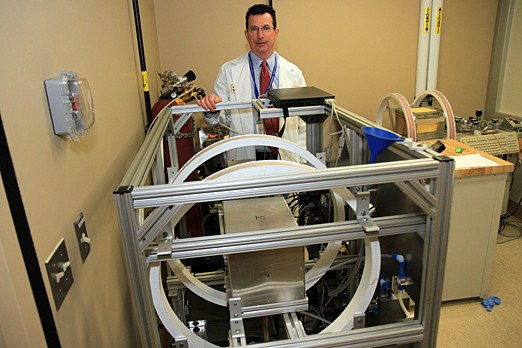Medical imaging has become brighter at the Thunder Bay Regional Health Sciences Centre.
MPP’s Bill Mauro (Lib. Thunder Bay – Atikokan) and Michael Gravelle (Lib, Thunder Bay – Superior North) announced $1 million in funding for the regional hospital. The funding will offset the cost of a new Xenon polarizer, which will be used for medical imaging.
The polarizer is part of the research conducted by Mitch Albert, a research chair and professor at Lakehead University.
Albert said his study looks at how polarized Xenon gas can help show a clearer and brighter MRI image. The polarizer uses the process of hyperpolarization to manipulate the xenon gas atoms to enhance the MRI signal.
He said there’s only a handful of people who are studying this kind of method in North America. He said the images produced using the gas compared to using liquids provides are higher in resolution, brighter and more accurate.
Patients who suffer from lung related diseases such as asthma will benefit by having the gas show an area where there is poor airflow. Albert said this could sometimes be missed with the current technology.
“Lung imaging is ready for prime time,” Albert said. “We’re doing active trials with patients with asthma, cystic fibrosis and chronic obstructive pulmonary disease. This gracious funding from Ontario is enabling us to buy the world’s best Xenon polarizer.”
Albert and his team started their research with a homemade polarizer but it didn’t provide high-resolution images. They also used Helium 3 but that became too costly as it was being heavily used by border patrols to find dirty bombs.
Xenon on the other hand is far cheaper and readily available, he said.
First Nation people have a high incident of COPD and other pulmonary diseases so they will be starting a study in order to provide better patient care, he said.
But the gas isn’t only just lung related illnesses.
Albert said they are also looking to use the gas for cancer treatment as well as medical imaging of the brain.
“This is brand new work and this has never been done before and we’re doing it right here in Thunder Bay,” he said. “It’s not only isolated to the lung.”
Birubi Biman, a physician at the TBRHS, said the new method will go a long way in helping patients.
“Initially it is in the research phase and what we try to do is explore its utility in dealing with patients who in my case have lung diseases,” Biman said. “With current technology what we do is take anatomic information so we get imaging from chest x-rays and CAT scanning. Both of those are static images and they rely on a picture at a point in time. This would combine both the anatomical as well as physiological information.”
She said that information combined will show how well someone is breathing, how much air is going into the lungs and how that changes over time. That’s information that they currently don’t have or measure, she said.
“This is quite exciting,” she said. “If it looks like new information then we probably have new treatment modalities or treatments that we are perhaps not doing.”
The polarizer is expected to arrive at the hospital in about five months.
